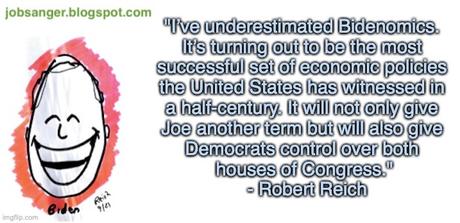
The following post is by Robert Reich:
Until recently, I assumed that Joe Biden would get a second term despite worries about his age because most Americans find Trump so loathsome.
But I’ve underestimated Bidenomics. It’s turning out to be the most successful set of economic policies the United States has witnessed in a half-century.
It will not only give Joe another term but will also give Democrats control over both houses of Congress. It may even put the nation on the path to widely-shared prosperity for a generation.
Consider what’s been happening to the economy. New economic data last week showed inflation cooled to 3 percent in June, down from over 9 percent last year, and close to the Fed’s goal of 2 percent.
And as inflation has subsided, real wages — that is, what paychecks will buy — have finally risen.
Meanwhile, economic growth has accelerated. Consumer spending is solid. Consumers expect the economy to continue to do well.
Inflation is coming down without a crash landing, in large part because the Fed’s rate increases — designed to slow the economy, stop wage growth, and cause higher unemployment — are being offset by Bidenomics’ massive public investments in infrastructure, semiconductors, wind and solar energy, and manufacturing.
This isn’t all. The Biden administration has added three other critical ingredients: the threat (and, in some cases, reality) of tough antitrust enforcement, a pro-labor National Labor Relations Board, and strict limits on Chinese imports.
Taken together, these policies are beginning to alter the structure of the American economy in favor of the bottom 90 percent.
Let me stop here for a moment to point out that there are two separate goals of economic policy.
The first goal is avoiding inflation or recession — that is, evening out the business cycle (often called achieving “price stability”).
In recent decades, the Fed has been in charge of this. It’s engaged in a “Perils of Pauline” ride — seeking to offset dramatic economic plunges (stemming from the financial crisis of 2008 to 2009 and then the pandemic of 2020) with zero and even minus-zero interest rates, while trying to offset an equally dramatic post-pandemic surge with the fastest and highest interest rate increases since the early 1980s.
The second goal is gaining more jobs at higher wages.
This requires altering the structure of the economy so the poor and working middle class get a larger share of the gains and the ownership class doesn’t continue to run away with the lion’s share.
The distribution of income and wealth doesn’t have to be a zero-sum game in which the rich do better only at the expense of everyone else, and everyone else can do better only if wealth at the top is constrained.
But power — the power to alter the rules of the game and organize the market to the advantage of those possessing it — is a zero-sum game. It’s exercised only to the extent that others can not. And in modern America, as we all know, great wealth turns into great power.
So, getting the poor and working middle class a larger share of the gains requires restructuring the economy in favor of the vast majority that has been losing ground for 40 years and against the monied interests that have been gaining it.
This restructuring has been difficult to achieve, for the simple reason that the monied interests don’t want it.
In Republican circles, the monied interests have preached the snake oil of supply-side economics, which legitimized giant tax cuts going mostly to the rich and large corporations.
Those tax cuts — under Reagan, George W. Bush, and Trump — exploded the federal debt, fueled giant profits in the biggest firms and financial institutions, and stoked a surge in billionaire wealth but did literally nothing for average working people.
In Democratic circles, the monied interests have used neoliberalism — which has called for deregulation, privatization, free trade, and the domination of finance over the economy. This orthodoxy pervaded the Clinton and Obama administrations. (I won’t bore you with my war stories, but trust me.)
The result was similar to the result of supply-side economics: Wealth surged to the top, but average working people remained stuck in the mud.
In contrast to both trickle-down economics and neoliberalism, the Biden administration is focused on altering the structure of the economy.
Over the past year, manufacturing construction in high-tech electronics, which the administration has subsidized through CHIPS and the Inflation Reduction Act, has quadrupled
Tens of billions in infrastructure spending has been funneled to the states for road, water system, and internet upgrades.
More clean-energy manufacturing facilities have been announced in the last year than in the previous seven combined.
Biden understands that these investments must translate into high-paying jobs, which often require unions. “When I think climate, I think jobs … union workers are the best workers in the world,” he said in a recent speech on Bidenomics.
The monied interests don’t want unions, of course. The narrow congressional majority that got these bills passed rolled back some of the labor conditions that were originally on the tax credits and grants.
Moreover, much of the funding is pouring into so-called “right-to-work states” that make it exceedingly difficulty to unionize.
But a buoyant economy strengthens the hand of workers, making it easier to unionize — which helps explain the ubiquitous labor action this summer.
Voters may not yet understand Bidenomics, but it’s probably not necessary that they do in order for Biden and the Democrats to benefit.
If Bidenomics continues to alter the structure of the economy in ways that help the vast majority, voters will give Biden another term and reward Democrats with both houses of Congress.
And if Bidenomics is successful, it will make the American economy both stronger and fairer in years to come.
I’m betting on it.

